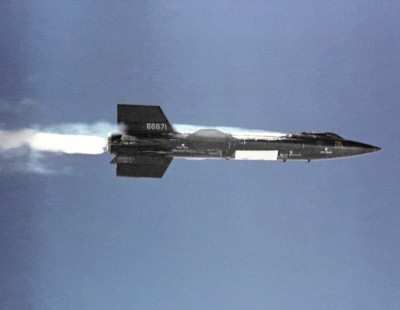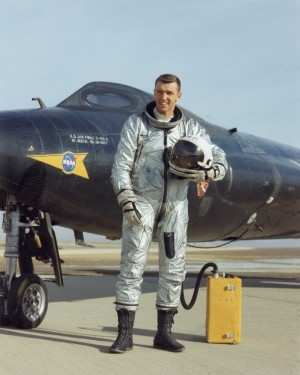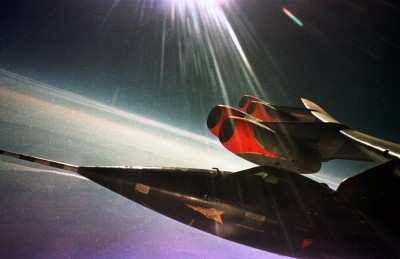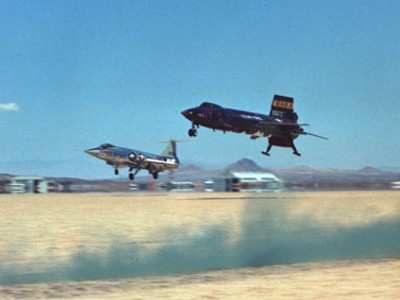First Powered X-15 Flight Was Fifty Years Ago September
17th
Fifty years ago in 1959, test pilot Scott Crossfield threw the
switch to ignite the twin XLR-11 engines of his North American
Aviation X-15 rocket plane and begin the storied test program's
first powered flight.

Photo Credit NASA
It was a real kick in the pants.
"The drop from the B-52 carrier aircraft was pretty abrupt, and
then when you lit that rocket a second or two later you definitely
felt it,” said Joe Engle, another X-15 test pilot and member
of the same exclusive fraternity of pilots that included Crossfield
and the eventual first man on the moon, Neil Armstrong. All took
the X-15 to speeds and altitudes that extended the frontiers of
flight.
The X-15 was a research scientist's dream. The experimental,
rocket-boosted aircraft flew 199 flights with 12 different pilots
at the controls from 1959 through 1968. It captured vital data on
the effects of hypersonic flight on man and machine that proved
invaluable to the nation's aeronautics researchers, including NASA
and developers of the space shuttle.

Joe Engle Photo Credit NASA
"That first powered flight was a real milestone in a program
that we still benefit from today," said Engle.
Engle knows what he’s talking about. The Kansas native
flew the X-15 for the U.S. Air Force 16 times from 1963 to 1965 and
went on to command two missions of NASA's space shuttle. Still an
active pilot, the retired major general fondly recalled what it was
like to fly the X-15 and how lessons learned then made possible the
space shuttle program years later.
"It was a very busy airplane to fly, but it also was a beautiful
airplane to fly; a very, very good solid flying vehicle.
Particularly when you were subsonic, in the landing pattern—
even at the lower supersonic speeds," Engle said.
Three times Engle flew an X-15 higher than 50 miles, officially
qualifying him for Air Force astronaut wings and providing him a
brief moment for sightseeing at the edge of space. "I didn't really
have time to soak up the view in the X-15 like I did later when I
flew the space shuttle," Engle said. "You could glance out and see
the blackness of space above and the extremely bright Earth below.
The horizon had the same bands of color you see from the shuttle,
with black on top, then purple to deep indigo, then blues and
whites. You were just so terribly busy flying the airplane, keeping
everything under control and watching for any deviations. And in
many cases, during re-entry flights for example, making sure the
airplane was perfectly lined up as you started to enter the
atmosphere."
Engle credits the X-15 for laying the foundation for many of the
operational techniques of the space shuttle, and for providing
designers with confidence that certain design and control concepts
for the winged orbiter would work:
- With similar flying characteristics, the X-15 proved the
shuttle could re-enter the atmosphere and glide to a precision
landing, in part relying on a maneuver known as Terminal Area
Energy Management where speed and altitude are carefully controlled
so the vehicle can reach the runway instead of falling short or
overflying it.
- Using technology developed and tested on the X-15, pilots
learned how to transition control smoothly from reaction control
jets at high altitudes or in space to wing- and tail-mounted
control surfaces in the atmosphere closer to the ground.
- While not a benefit to the space shuttle alone, the X-15 was
the first flight test program to make extensive use of simulators
to work out certain problems and train pilots before going
up—a practice since employed for nearly every flight test
program.
- The X-15 flights proved the usefulness of having chase aircraft
follow a test vehicle during its approach to the runway to make
sure, as Engle put it: "Everything that is supposed to be up is up,
and everything that is supposed to be down is down."
The X-15 was suggested in the early 1950s by Bell Aircraft's
Walter Dornberger as a vehicle for exploring the realm of
hypersonic flight, which was defined as a speed in excess of Mach
5, or five times the speed of sound. The earliest days of the X-15
program were shaped by the National Advisory Committee for
Aeronautics, the federal agency which NASA replaced in 1958.
The NACA, Air Force and Navy all had an
interest in the program and all provided resources, including
pilots. Eventually the Navy stopped supporting the X-15 in order to
concentrate on aircraft carrier operations, Engle said. By the time
contracts for the airframe and engine were signed with North
American Aviation in 1955 and Reaction Motors in 1956, the program
had goals of flying the X-15 to a speed of Mach 6 and an altitude
of 225,000 feet.

Photo Credit NASA
"It was a pretty aggressive move, a pretty gutsy step. We had
reached Mach 1, 2 and even 2.5 in other airplanes. But then we lost
a pilot when he crashed in one of those airplanes after reaching
Mach 3," Engle said. "So the next step was Mach 6?"
As the prime contractor for the X-15 airframe, North American
Aviation was responsible for checking out the vehicle before
turning it over to the NACA, Air Force and Navy team so research
flights could begin. It was up to the company’s chief test
pilot, Scott Crossfield, to take the controls for the initial
flights.
Crossfield flew a handful of captive
flights with the X-15 slung beneath the wing of a B-52 mother ship.
Some were intentional and some were not, as initial attempts for a
drop test were aborted. Crossfield and his rocket plane finally
were released from the B-52 on June 8, 1959, to make an unpowered
glide to the lakebed below at Edwards Air Force Base in
California.
With the X-15’s primary rocket engine, the XLR-99, still a
few months away from being ready to fly, two of the smaller XLR-11
rockets were installed into the X-15 for Crossfield to use in
making the first powered flight on Sept. 17, 1959.
The X-15 worked as anticipated that day, reaching a modest
altitude of 52,341 feet, but easily breaking the sound barrier and
recording a top speed of Mach 2.11 during the nine-minute flight.
"It was a big step, you bet," Engle said. "It showed that the
propulsion unit was compatible with the airframe and that it would
work. Crossfield was able to demonstrate the airplane would launch,
fly free from the B-52, and that it could go supersonic without
picking up any handling problems going through the transonic
region."

Photo Credit NASA
The X-15 set world records for altitude and speed, but more
importantly the research conducted during those test missions
provided data that would benefit future operations and
investigations related to aeronautics and spaceflight. "I think
they far exceeded what they thought was going to be the design
parameters for the X-15 program. They wanted to achieve Mach 6 and
they got to Mach 6.7. The design altitude was 225,000 feet and
(NASA pilot) Joe Walker got it to 354,200 feet," Engle said.
But reaching those numbers didn't automatically allow the X-15's
designers and pilots to declare success, Engle said. The whole
process they went through to get to that point is where the lessons
were taught and learned, sometimes harshly. In 1967, Air Force
pilot Michael Adams was killed in the crash of an X-15.
"You learn so very much during the envelope expansion. Yes,
there are some potholes that live within the envelope that you have
to learn how to solve or avoid. But it's just as valuable to learn
those as it is the lessons that wait for you at the edge of the
envelope," Engle said.
 Airborne 04.16.24: RV Update, Affordable Flying Expo, Diamond Lil
Airborne 04.16.24: RV Update, Affordable Flying Expo, Diamond Lil ANN's Daily Aero-Term (04.20.24): Light Gun
ANN's Daily Aero-Term (04.20.24): Light Gun Aero-News: Quote of the Day (04.20.24)
Aero-News: Quote of the Day (04.20.24) Aero-News: Quote of the Day (04.21.24)
Aero-News: Quote of the Day (04.21.24) ANN's Daily Aero-Term (04.21.24): Aircraft Conflict
ANN's Daily Aero-Term (04.21.24): Aircraft Conflict






